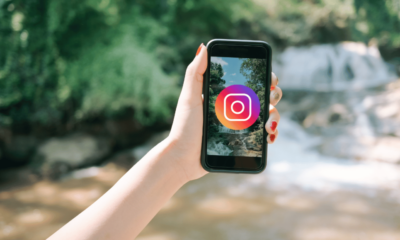Tech
iPhone vs Android: What’s Best for Content Creators?
Read to learn if iPhone or Android can help you generate the best quality content and turn it into gold.

Hello! Content creators of Instagram, YouTube, and other platforms, you must know your smartphone isn’t just a device; it’s your portable studio, a production house that makes you go viral.
Whether you’re a budding influencer or an experienced creator, choosing between an iPhone and Android is a decision of force and gut. Both OS bring unique strengths, but which genuinely fits your creative needs?
Let’s learn everything we need to set them apart.
Camera Quality: Does Pixel Matter?
iPhone:
Ask any content creator, and they’ll tell you that iPhones are known for their incredible camera quality. The colour accuracy, depth range and consistency across all models make them ideal for posts, reels and YouTube videos. You can click a casual selfie or a cinematic vlog; the iPhone delivers satisfactory results straight from the camera. Features like Cinematic Mode (on newer models) and ProRAW elevate it for creators who want DSLR-like quality in their pocket.
Android:
Unlike flagship models like the Samsung Galaxy S series and Google Pixel series, very few Vivo, Oppo, Nothing and Xiaomi phones run like iPhones. Samsung has more vibrant, punchy colours and zoom capabilities, while Google Pixel phones offer computational photography, perfect for night shots or moody Instagram aesthetics. However, Android’s camera performance can vary drastically depending on the model and price point, which makes choosing the right phone crucial.
Video Capabilities: Which records the best?
iPhone:
iPhones are a no-brainer for many creators. They support 4K recording at up to 60fps across all lenses and offer smooth stabilization, perfect for handheld / hurry shots. Apple’s A-series chips process video effortlessly, leaving no lag or overheating while filming lengthy YouTube content. For Instagram, you’ll love the direct upload quality, no extra tweaking is required.
Android:
High-end Android phones match iPhones in video specs, offering 8K recording on some models (only Samsung’s flagships) and advanced features like Steady Mode for action shots. However, Android struggles with video compression when uploading directly to Instagram or YouTube. You might notice a drop in quality, which means extra steps for editing and exporting.
App Optimization: How do Instagram and YouTube run?
iPhone:
Instagram was first made for iPhone when the app launched in 2010. It was only available for iPhone users until 2 years later when they made it for Andriod. Until today, the app’s interface, navigation, and codes have been written for high-quality visuals aligned with Apple’s design and software.
If you’re using Instagram or YouTube Studio on an iPhone, you’ll notice the apps run smoother, faster and better optimized. Instagram Stories and Reels upload in their native resolution, maintaining high quality. YouTube’s app on iOS integrates seamlessly with features like HDR playback, making it a preferred choice for creators who value simplicity.
The iPhone’s camera quality and advanced editing tools made it the ideal companion for Instagram, enabling users to produce aesthetically pleasing photos with minimal effort.
Android:
Android’s open ecosystem is a drawback. Instagram can only sometimes be perfectly optimized, no matter what we do, they can only upload lower-quality videos or show glitchy features. However, YouTube’s Android app now offers advanced features like higher resolution live streaming and adequate control over playback settings, making it a solid choice for serious creators.
Editing Tools: Which OS polishes your content better?
iPhone:
Editing your photos and videos is easy, thanks to apps like iMovie, Final Cut Pro (Only Mac integration), and Lightroom made for iPhone. Apple’s hardware is optimized for editing with less lag and faster rendering times. Tools like Airdrop make transferring files to your laptop (Only if you have a Mac) seamless. The Apple Bundle costs heavily, which one cannot afford easily, but it is a massive plus for creators juggling multiple devices.
Android:
Android users, too, have a wide range of third-party editing apps like InShot, KineMaster and more. The advantage? You can customize and tweak files at a level iOS doesn’t always allow. However, rendering times may vary depending on your device’s processor. On the brighter side, these apps function better on Android because of fewer restrictions on their permissions and compatibility with the OS.
Battery Life: Which dies first?
iPhone:
Only the Pro models are known for battery efficiency. Whether you’re live streaming on Instagram or editing, the optimized hardware and software ensure your phone doesn’t die mid-task. Fast charging and MagSafe compatibility add to the convenience at extra expense. The iPhone isn’t just about specs and convenience but also money and money.
Android:
A few high-end and gaming Android phones have larger batteries and faster charging options, making them perfect for extended shooting sessions. But again, the experience depends on the model; sorry folks, but budget Android phones may not hold up under heavy usage like you want them to.
Storage and File Management: Which can offer you and your creativity better room?
iPhone:
With storage options up to 1TB (for the rich), iPhones have plenty of space to store high-quality videos and photos. You also have iCloud for extra storage, which comes with subscription costs. File transfers are smooth within the Apple ecosystem but can be a hassle connecting to non-Apple devices.
Android:
Most Android phones support expandable storage via SD cards, a lifesaver for creators with a lot of content. Transferring files is also more straightforward, with drag-and-drop capabilities or using a cable to a computer.
Price: Which is affordable?
iPhone:
It’s a naked fact that iPhones are expensive. However, for creators, the price often feels justified for the premium build, camera, and app optimization. If your content game is on point and you can invest in the business, understand that the investment pays off in quality and ease of use.
Android:
Android phones cater to every price point. You can find mid-range options delivering solid performance or flagships with many models and extra features. But for budding creators, Android offers the flexibility to upgrade as your career grows; it’s okay to look on this side, too.
Is it time for a Verdict? What’s best for content creators?
If you value consistency, simple design and seamless operation, the iPhone is your go-to. It’s the top choice for Instagrammers and YouTubers who want their content to look polished without too much post-production effort.
On the other hand, if you’re a creator who loves customization, flexibility, and experimenting with features, Android offers endless possibilities. Flagship models can match and sometimes exceed iPhones in creative capabilities.
But, is my opinion the end-all?
I tried to write about my expertise and share my knowledge. At the end of the day, your choice depends on your style, budget, and the platform on which you want to shine the most.
Whichever device you choose, remember: your creativity matters, and it sets you apart, not the phone you use! It’ll definitely make your work simple, based on your choice.
Good Luck with all your future endeavours and happy content creation!
Keep coming back for more!









































